This feature will outline chef/owner Stuart Ralston’s background and career as a chef before analysing his cuisine against the criteria Michelin use for awarding a star. Aizle currently enjoys 6/10 in the Good Food Guide and is aspiring to a first star.

[Chef/Owner of Aizle, Stuart Ralston]
Cooking is in Stuart’s blood. His inspiration to become a chef came from his parents and brother, all of whom were chefs. Growing up in an environment of restaurants and hotels, he started working for his father at the age of 13 as a kitchen porter. From 16, he began to take the industry more seriously, gaining placements in other leading Scottish restaurants. Ian McNaught at Roman Camp and David Williams at Greywalls in Guillane became his teachers and mentors. Stuart also had experience at Inverlochy Castle. Aspirationally, Stuart’s inspiration was Gordon Ramsay, whose blossoming career he avidly followed, with a keen desire to work for him.
This finally happened when he trialled at Gordon Ramsay at the Connaught. Then came Stuart’s biggest break when he was transferred to Ramsay’s eponymous two Michelin starred restaurant in New York. Over two years, he was able to work in all sections, moving from commis chef to senior chef de partie. This huge leap in his career, in a team who progressed to become top chefs around the world, and with connections made through Gordon Ramsay, boosted Stuart’s reputation and international standing. Thus he was offered jobs in two and three star New York restaurants, settling in a position at the three Michelin starred Jean-Georges. This was cut short by the financial crisis, but he gained another top position executive chef at the exclusive Core Club.
After five years in the Big Apple, Stuart returned to the UK, being appointed Head Chef at Lower Slaughter Manor where he gained three AA rosettes and was inspected for a Michelin star. However, a year later, the company went out of business, a bittersweet moment as coincidentally he was offered the Head Chef position at the opulent, world-famous Sandy Lane Hotel in Barbados. He stayed there for three years, part of a culinary team that oversaw five kitchens with 120 chefs and massive revenues.
Having been away from Scotland for ten years, Stuart decided to make his name in his homeland, and Edinburgh in particular, where leading chefs such as Tom Kitchin and Martin Wishart had given the capital gastronomic credibility in the buzzing restaurant scene.
Passionate about being independent, finances enabled him to open Aizle in Edinburgh’s Southside without the need for investors. “Humble, small and low key” – the opposite of Sandy Lane – it made a quick impact as a tasting menu only restaurant, the first in Edinburgh. Over five and a half years he has gained a large and loyal clientele, demonstrating that a no-choice menu can have wide appeal if done well. Consequently, amongst other accolades, Aizle has been voted fifth best restaurant in the UK and second best in Edinburgh by Trip Advisor. After three years of inclusion in the Good Food Guide, the 2020 edition has finally appreciated the hard work and incremental changes it has made over time, awarding the highest mark so far of 6/10.
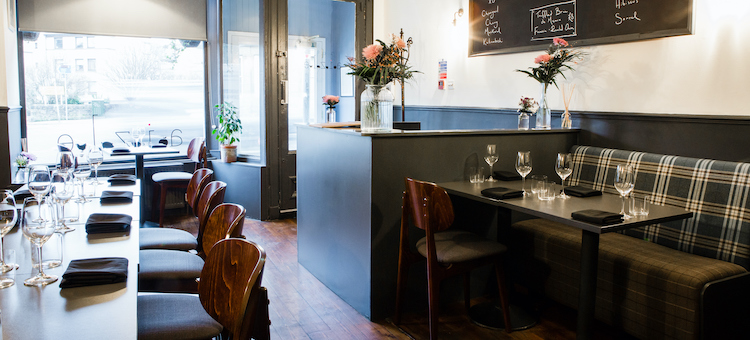
Aizle’s pastel blue frontage with large picture windows displays an ingenious nature inspired graphic design which incorporates the restaurant’s name above the entrance. Inside, the shades of blue, grey and cream give a warm, comforting feel. Décor in the high ceiling room is kept to a minimum, the main features being two blackboards listing the ingredients of the dishes on the menu. Clearly, the focus is on the food, with few distractions. Even the menu cannot be read until the end of the meal, when it is handed to the diner. Instead, the engaging and knowledgeable staff, who may include the person who cooked it, present and explain each dish as it arrives.
The rest of this feature will analyse Stuart Ralston’s cuisine against aspects of the five criteria used by Michelin for awarding a Michelin star: cooking techniques employed; balance and harmony in flavour; consistency across the menu and over time; provenance of ingredients; and value for money
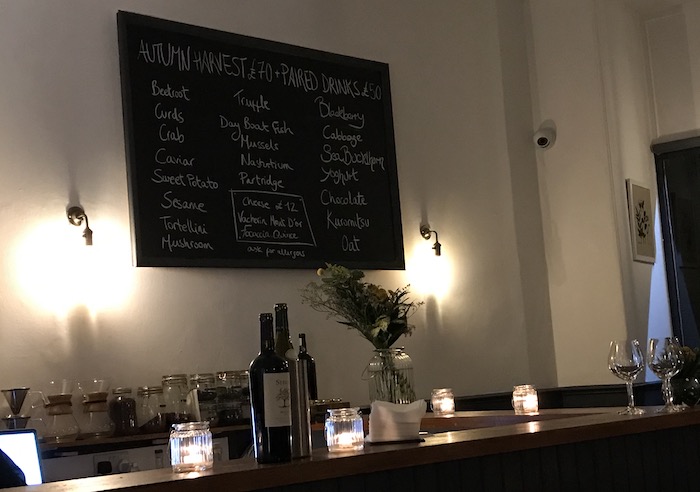
Stuart uses mainly classical techniques with modern flavour combinations. A simple chocolate mousse is executed in a classical way involving emulsification and is often paired with salty, umami Japanese elements. Aged beef with cherry mustard, involving barbequing and grilling on a Japanese grill to produce a simplistic beautiful flavour has been skilfully employed, hence the dish is available often throughout the year. Conversely, a summer dish of Cod with sweet corn succotash with katsuobushi sauce, involves the classical techniques of fermentation and pureeing.
Sous vide is not employed on a day to day basis. It is never used to cook fish. Game birds are roasted whole. Cooking meat and fish in a pan is the preferred classical method. Confidence, and actually being present to ensure precise timing, is essential for success. As Stuart is present at every service, consistency is guaranteed. He agrees that sous vide can be employed successfully in the highest level restaurants but can be misused in lesser establishments.
Whilst balance and harmony are taken into account in the creation of a new dish and menu, Stuart believes some ingredients in a dish may be (say) dominantly rich or acidic with good reason, to allow the flavours and profile to be bold. This does not mean a dish cannot be in equilibrium.

Consider the first, labour intensive, snack on the tasting menu: fresh, very rich goat’s curd encased in a sweet, delicate beetroot glass tube, with an acidic gel in the middle which helps balance the other two elements. Pine nuts add an interesting harmonious background. Essentially sweet and rich, a combination common with cheese, such as cheese and chutney, this snack is a successful “one bite, one shot opener which grabs the diner’s attention at the start of the meal.”
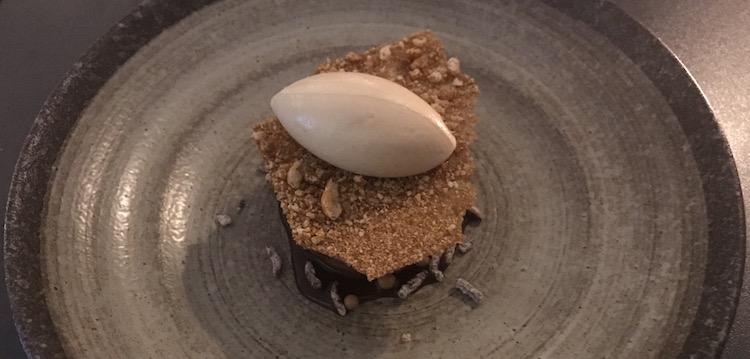
At the other end of the meal is chocolate mousse. The main ingredient from the celebrated Norman chocolatier, Michel Cluizel, has a malty, salty, caramel quality. It rests on Black sugar from Okinawa reduced right down with Scottish whiskey. A wafer thin nut praline is topped with Kinako ice cream of roasted soya bean flower. These elements give a quite tonal and therefore balanced character, with the combination of chocolate, nuts, milk and salt, giving a balanced, rich and comforting feel.
Harmony and balance across the whole menu is also carefully considered in terms of tastes, textures, temperatures and range of ingredients. Dishes also progress from small to large.

The second snack, sweet potato with teryaki and sesame is hot and fried, comforting and warming, with a very different robust profile.

By contrast, the third snack, a crab tartlet with caviar and apple is luxurious with delicately thin filo pastry
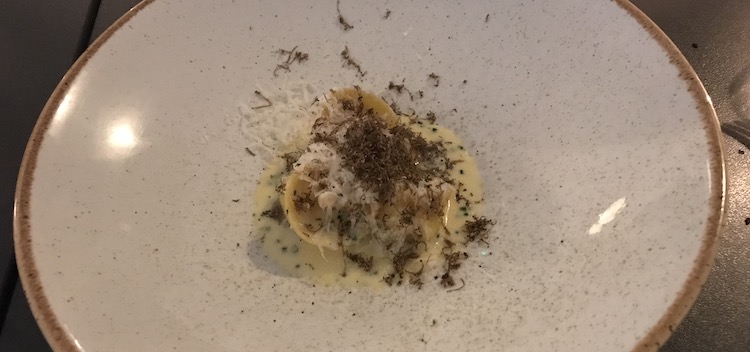
The first course always highlights a vegetable, in this case a super comforting and fragrantly luxurious dish of girolles served with ricotta tortellini, aged parmesan and Italian black truffle.
Bread is served as the next course to balance the previous smaller snacks and as a prelude to the more substantial fish and meat courses. Served by the pastry chef, the mother base of the sourdough named Roger is four and a half years old. The warm rolls are flavoured with caramelised onion, lemon thyme and black garlic and served with cultured butter made in house.
The fish and meat courses flow naturally in succession:

Isle of Gigha halibut with Shetland mussels and Ken Holland broccoli, employs prime ingredients precisely timed to maximise their inherent delicate flavours
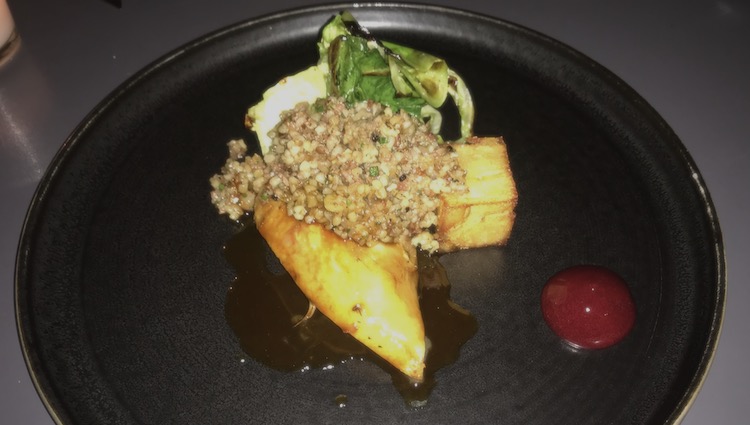
A game dish features breast of wild partridge topped with smoked sausage haggis and served with cabbage, Pommes Anna and a blackberry gel captured more robust, earthy flavours and textures.
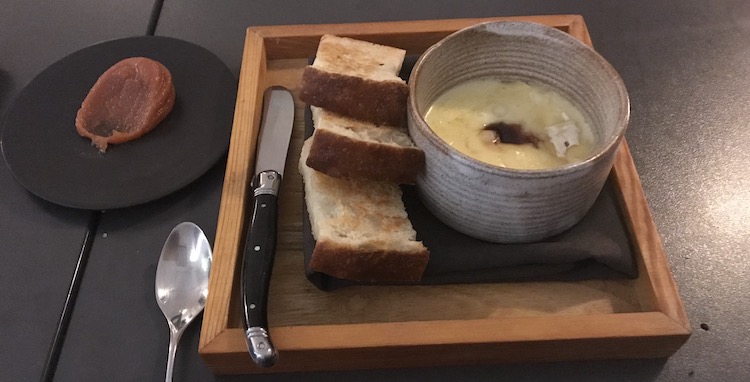
Vacherin Mont d’Or baked with Edinburgh blossom honey, and served with quince purée and homemade focaccia, provides a stimulating savoury and sweet, hot and cold cheese course
To balance this, a pre dessert of sea buckthorn (reduced down with sugar and carrot juice to moderate it is intense sharpness), yoghurt and lemon balm is suitably cold and acidic to act as a palate cleanser before the final rich dessert.
A rich chocolate mousse, described above, and dainty petit fours complete this sensational menu.
Consistency at a basic level involves everything being weighed: for instance, fish portions at 65 grams, bread rolls at 55 grams, tartlets have the same amount of crab and are of the same size and shape.
Consistency in standards is achieved by ensuring each chef cooks at the same station in each of the four open evenings, Wednesday to Saturday. Changes only occur when Stuart is convinced mastery has been achieved in his or her section. Closing three days a week ensures staff are not exhausted, retaining their energy, passion and enthusiasm. The team is energised as they feel ownership of the restaurant as part of a team with important responsibilities. Everyone takes holidays at the same time to negate any problems if Stuart is absent. Overseeing the service each day, Stuart himself ensures that no dishes leave the passe without his approval.
Consistency with suppliers is achieved by good relations built over 10 to 15 years. They know the high quality Stuart demands. Only big fish are bought for flavour and only wild fish and game are sourced. Daily orders are checked to ensure quality, size and presentation..
At Aizle, Scotland’s bounteous larder is exploited to the full for its seasonal menus: Gigha halibut, Shetland mussels, wild partridge, girolles, blackberries, sea buckthorn and blossom honey all feature in the autumn menu. Other top quality and seasonal ingredients are sourced from notable suppliers: broccoli from specialist grower Ken Holland’s farm in Northumberland; Aged Parmesan and black truffle from Italy; and Vacherin Mont d’Or and Martin Cluizel chocolate from France. Given Stuart’s extensive knowledge of Far Eastern ingredients, Katsuobushi, Okinawa black sugar and Kinako, roasted soya bean flour, are sourced from Japan. As mentioned above, daily deliveries are thoroughly checked for quality, size and presentation.
Stuart sees value for money partly in terms of how people feel when they leave a restaurant: have they got something for their money; have they been looked after; have they been impressed with the standard of ingredients? Examining the list above, wild fish and game, caviar, truffles, expensive French cheese and chocolate are quality, luxury ingredients that come at a cost which most guests appreciate. That many are repeat customers, some having eaten at Aizle 40 to 50 times over five years, is testament to its success in this respect. From an economics point of view, there has to be value in the meal, as certain costs have to be achieved, these being pushed to the limit in buying the best yet keeping the restaurant sustainable. Overall, a huge effort is made at Aizle, including learning from previous mistakes, to achieve value for money at its price point.
Having cooked for 23 years, Stuart’s energies at the age of 36 are still undiminished. Indeed, August this year saw the opening of his second restaurant, Noto, in Thistle Street. More casual than Aizle, and open all week, it has a neighbourhood feel. Serving a small plates menu with Asian influences, Noto has received good reviews, keeping its strong team constantly busy serving 48 covers with 110 on Saturdays. Stuart aims to keep cooking at Aizle, but splits his time between the two restaurants, empowering managers and senior staff, who have been loyal to the company. In the long term, perhaps another restaurant on the lines of Noto may be envisaged.

[Richard (chef de partie), Danielle (chef de partie) Stuart Ralston (chef owner), Tobias (pastry)]
Aizle, which means a “burning coal, a glowing hot ember, a spark” will undoubtedly continue to burn bright. Stuart’s investment in people, at Aizle and at Noto, has clearly paid dividends. With its team of four chefs and four front of house serving fifteen tables, Aizle has gone from strength to strength. It will remain Stuart’s main focus of attention, as he cooks here each service. Fine Dining Guide enjoyed its meal and meeting with Stuart and will look forward to the restaurant’s increased recognition in the national restaurant guides. A Michelin star cannot be too far away.



